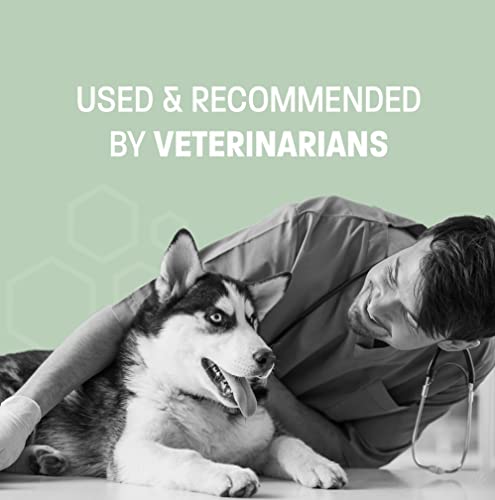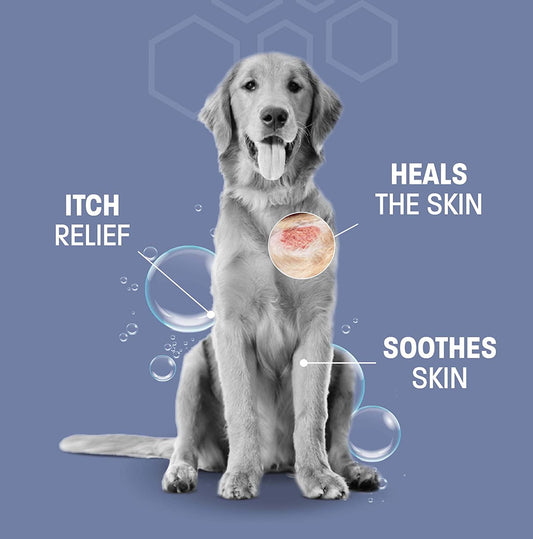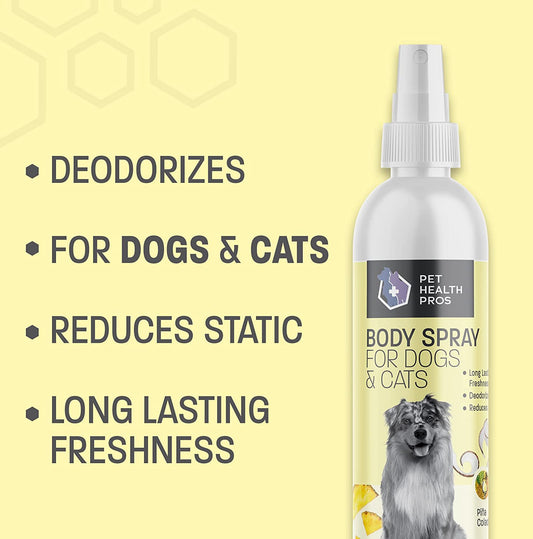Prevention is better than cure, especially when it comes to our pets. Pet Health Pros offers invaluable tips to safeguard your dog against ringworm and highlights how our medicated products can help keep your pet's skin healthy.
Ringworm is a common fungal infection that affects dogs of all breeds and sizes. It's caused by a group of fungi called dermatophytes, which thrive in warm, humid environments. Even though it's not life-threatening, it can be uncomfortable for your pup and may lead to other infections if left untreated. So, prevention is key!
Hygiene is the first step: bathe your pup with antifungal shampoo containing ketoconazole; use an antiseptic solution like chlorhexidine to clean their bedding and grooming tools. Also, keep their environment clean and dry. Ringworm loves moist spots, so make sure you clean and disinfect your pup's living space often.
If you have multiple pets, isolate any infected ones until they get treated. Make sure each pet has their own stuff - food/water bowls, toys, bedding - to avoid contact with contaminated items.
Understand the history of ringworm. Despite its name, it's not caused by a worm, but by a fungus that infects the outer layer of skin. The term "ringworm" comes from the characteristic red or raised rings on human skin when infected. Dogs are susceptible because of their close contact with contaminated environments.
Follow these proactive measures, maintain hygiene, and consult with your vet if you think your pup has ringworm. Early detection and treatment are important for a speedy recovery. Your diligence and care will help keep your pup happy, healthy, and free from this pesky fungal infection.
Understanding Ringworm in Dogs
To understand ringworm in dogs, grasp the definition and causes of ringworm as well as the symptoms and signs of this condition. Get familiar with the sub-sections 'Definition and Causes of Ringworm' and 'Symptoms and Signs of Ringworm' to find effective solutions using antiseptics, antibacterials, antifungals like ketoconazole, and chlorhexidine.
Definition and Causes of Ringworm
Ringworm is a fungal infection which affects dogs. It is caused by different types of fungi, such as Microsporum canis and Trichophyton mentagrophytes. Direct contact with an infected animal or contaminated items helps it to spread easily.
This contagious disease often has patches of hair loss in circular shapes. Redness and itching go along with it. Puppies, older dogs, and those with weak immunity are more vulnerable to this infection.
To diagnose ringworm in dogs, vets may use Wood's lamp examination or collect fur samples for testing. Treatment usually includes antifungal medications, medicated shampoos, and cleaning the dog's environment often.
Pro Tip: Inspect your dog's coat regularly for any signs of ringworm. This will help you detect it early and prevent it from spreading to other pets or humans in your home.
Symptoms and Signs of Ringworm
Got a pup with ringworm? It's essential to recognize the signs! Here are some common symptoms to look out for:
- Red, circular lesions. Can be scaly or crusty.
- Hair loss in patches or widespread.
- Itching and irritation at the site of infection.
- Cracked, dry skin.
- Secondary bacterial infections, like pus-filled sores or a foul smell.
Not every dog will show all signs. So, if you suspect ringworm, seek a vet for an accurate diagnosis ASAP. This will help prevent the infection from spreading! Provide your furry friend with the care they need. Schedule a visit today. Early intervention is key!
Proactive Measures to Prevent Ringworm in Dogs
To prevent ringworm in dogs, implement proactive measures using regular cleaning and grooming, antiseptic and antibacterial products, antifungal treatments, maintaining a clean and healthy environment, and regularly checking for signs of infection. These measures will help ensure the well-being and health of your beloved canine companion.
Importance of Regular Cleaning and Grooming
Regular cleaning and grooming are musts for ringworm prevention in dogs. Proper hygiene lowers the infection risk and keeps your pup healthy. Clean bedding often since fungus spores causing ringworm can be present. Also, brushing your dog's fur helps remove dirt and debris, preventing bad microorganisms from building up. Plus, trim their nails regularly too, since long nails can trap dirt and boost the infection risk. When bathing, vet-recommended shampoos and products are key for optimal skin health.
For further prevention of ringworm, some unique practices can be used. Firstly, apply antifungal sprays or powders to spots where your dog often goes. This helps kill or repel fungi in the home environment. Secondly, clean and sanitize shared items like toys or brushes, to avoid the spread of ringworm between pets and family. Lastly, having your dog's living space well-ventilated reduces moisture levels and minimizes fungus growth.
Pro Tip: If you see signs of ringworm like circular patches on your dog's skin or too much scratching, head to a vet right away. Early detection and swift treatment avoids further spread and discomfort for your pet.
To keep your pet and home environment safe from ringworm, regular cleaning and grooming are essential. Be proactive in maintaining cleanliness for your pup's health and your home's cleanliness.
Using Antiseptic and Antibacterial Products
Regular cleaning and disinfecting of the pup's living area with antiseptic sprays or wipes is key in eliminating spores or fungus growth. Special shampoos for dogs can be used to destroy any existing infection during baths. Moreover, topical antifungal creams or ointments with miconazole or clotrimazole can be applied to affected areas with a vet's directions. Even antifungal powders can be used to absorb moisture and prevent fungi on the dog's skin.
Be aware! Not all antiseptic and antibacterial products are safe for use on dogs. Make sure to check with your vet before using any new product to ensure it's suitable and to avoid any adverse reactions.
Ringworm is highly contagious and can spread to other animals or humans easily. Therefore, it is best to take preventive measures with antiseptic and antibacterial products.
The American Kennel Club attests that proper hygiene practices plus regular use of antiseptic and antibacterial products can be effective in preventing ringworm in dogs. Hence, dog owners should prioritize the use of these products for the overall health and wellbeing of their pet.
Explanation of Antiseptic and Antibacterial Properties
Antiseptic and antibacterial properties are key to stopping ringworm in dogs. These properties help to eliminate bad bacteria and fungi that cause infections. Here are four points that explain their importance:
- Antiseptics stop microorganisms from growing on living tissues. They kill or stop the growth of bacteria, viruses, and fungi. Applying antiseptics to surfaces where dogs touch fungus can stop ringworm.
- Antibacterials eliminate microorganisms that cause infections. They stop secondary bacterial infections that can come with ringworm. Applying antibacterials to wounds caused by scratching or ringworm lesions can help.
- Cleaning and disinfection are important to stop the spread of ringworm. Disinfectants with antiseptic and antibacterial properties should be used to clean areas where infected dogs go. This reduces the risk of reinfection and stops the spread of the fungus.
- Only use products formulated for dogs. Human products could be toxic to pets. Speak to a vet to make sure you use the right, safe products.
Good hygiene, like regular bathing and grooming, can also help stop ringworm. So, use antiseptic and antibacterial products, and take action today to give your dog a healthy, ringworm-free life.
Recommended Antiseptic and Antibacterial Products
When it comes to preventing ringworm in dogs, antiseptic and antibacterial products are key. These products can kill the fungus causing ringworm and stop the infection from spreading. Chlorhexidine is one such product - a powerful antiseptic that works on many bacteria and fungi. Use it as a rinse or a topical solution to clean the affected area. Another recommended product is povidone-iodine, with strong antimicrobial properties. Miconazole and clotrimazole are antifungal medications. They come as shampoos, creams, or sprays and can be applied directly to the infected area. Remember to always consult a vet before using any medication on your dog.
In the early 20th century, researchers identified iodine as an antiseptic agent against fungal infections like ringworm. This changed the treatment of ringworm in both humans and animals. Since then, various antiseptic and antibacterial products have been developed to tackle this contagious skin infection.
Utilizing Antifungal Treatments
Antifungal treatments are key for preventing ringworm in dogs. These treatments target the cause of the infection, helping ease discomfort and stop it from spreading.
Topical creams and ointments are useful. Also, antifungal shampoos can remove the fungus, reducing the risk of reinfection. Follow your vet's instructions for optimal results.
Oral antifungal medications are another option. These are prescribed based on the severity and the dog's health. Administering them and completing the course can improve your dog's chances of overcoming ringworm.
To avoid spreading to other pets or family members, keep good hygiene practices. Clean and disinfect bedding, toys, and grooming tools. Ensure all pets in your household have preventive care and regular check-ups to detect signs of infection early.
By using antifungal treatments and following hygiene practices, you can protect your canine companion from the discomfort and consequences of ringworm. Take action now before an outbreak occurs. Prevention is better than cure!
Explanation of Antifungal Properties
Antifungal properties are key to stopping ringworm in dogs. These properties help eliminate the fungal infection which causes ringworm, keeping dogs healthy and free of this common skin problem.
Dog owners can take preventative measures by understanding antifungal properties. Ingredients like ketoconazole and miconazole found in antifungal creams and shampoos can disrupt the cell walls of fungi, resulting in their death. This not only treats existing problems, but also stops new ones from forming.
Moreover, natural remedies like tea tree oil and apple cider vinegar provide antifungal properties with antimicrobial activity against fungi. This makes them advantageous additions to a dog's grooming routine.
It is essential to remember that these antifungal treatments must be used with a veterinarian's guidance. They will decide the most fitting treatment plan for a specific dog depending on their overall health and the intensity of the infection.
Recommended Antifungal Treatments (e.g., Ketoconazole)
Ketoconazole is a highly recommended antifungal treatment for preventing ringworm in dogs. It stops the growth of the fungus that causes it. Not only does it clear existing infections, but it also stops future ones by making it tough for fungi to survive.
Miconazole is another useful antifungal. It destroys cell membranes of fungi, killing them. This medication can be applied to skin or taken orally. Following the dosage and timeframe prescribed by a vet is important for success.
Terbinafine is another antifungal. It blocks an enzyme that fungi need to grow, which stops the infection. It comes as topical or oral.
To prevent ringworm, dog owners should groom and bathe their pet regularly. Also, keep the living area clean. Disinfect bedding, toys, and common areas.
Practice good hygiene when handling or interacting with infected animals or surfaces. Wash hands properly after contact, and don't have skin-to-skin contact with infected animals.
It is possible to protect dogs from ringworm. Use antifungal treatments like Ketoconazole and take preventive measures. Early detection and treatment are essential for a quick recovery and avoiding spread.
Maintaining a Clean and Healthy Environment
A clean, healthy environment is key to keeping ringworm away from dogs. Cleaning their space, bedding, and toys often can help get rid of fungal spores that cause the infection. Using pet-friendly disinfectants and vacuuming frequently can also reduce the risk.
Ventilation in dog kennels or living areas is important. Ringworm likes warm and humid spots. Opening windows or using fans can help keep the air fresh, lessening the chances of fungus growth.
Checking the dogs for any signs of ringworm - like red patches, circular lesions, or excessive itching - is important too. This way, you can detect the infection early and stop it from spreading to other pets and humans.
Regular Cleaning and Disinfection Practices
Regular cleaning and disinfection are key to avoiding ringworm in dogs. This reduces the chance of spreading the fungus to other animals and people. To clean the area, use a vacuum or broom to sweep up any dirt, fur or debris. Then disinfect surfaces with a pet-friendly antiseptic. Moreover, wash your pet's bedding and toys in hot water and detergent. Clean grooming tools, like combs and brushes, too - disinfecting them with the right solution.
Also, don't share towels or clothing with an infected dog. These items can carry the fungus which may cause infection.
To further prevent ringworm: groom your dog's fur often; keep good hygiene practices; avoid contact with strays or those with skin issues; and, if you see unusual changes in your pup's skin or fur, visit a vet straight away.
Through these steps, you'll keep your pup safe from ringworm while protecting other pets and humans!
Managing Infected Items and Areas
Managing Infected Items and Areas:
To fight against ringworm in dogs, it's important to manage infected items and areas correctly. This includes cleaning properly to stop the fungus from spreading and to keep your canine friend healthy.
- Thorough Cleaning: Wash all items that have been in contact with the infected dog - e.g. bedding, brushes and toys - with hot water and a strong disinfectant.
- Isolate Infected Items: Stop cross-contamination by keeping contaminated items in a special place or putting them in separate bags until they can be sanitized.
- Regular Vacuuming: Vacuum surfaces to remove spores that may have settled on carpets, furniture or floors. Get rid of the vacuum bag or canister right away afterwards.
- Disinfect Living Areas: Clean and disinfect all areas where your pet goes regularly. Pay special attention to floors, walls and crates where spores can easily accumulate.
- Avoid Sharing Personal Items: To stop ringworm spreading, don't share personal items with an infected dog - e.g. towels, blankets or grooming tools.
- Consult a Professional: If you're unsure how to handle infected items and areas, ask a vet or pet groomer for help.
Strict management of infected items and areas can reduce the odds of ringworm moving between your dogs. Prevention is key!
True Fact: According to the American Kennel Club (AKC), ringworm is contagious. However, regular cleaning and proper hygiene practices for your pets and their stuff can help prevent it.
Regularly Checking for Any Signs of Infection
It's vital to check for infections regularly to avoid ringworm in dogs. By being alert to your pup's health, you can detect potential infections quickly and take steps to treat them speedily. This will guard your dog from the distress and issues that come with ringworm.
To make sure of infection signs, try these three simple tips:
-
Visual Check:
Often inspect your pup's skin, fur and nails for any unusualities or changes. Look out for redness, swelling, itchiness, bald patches, scaly skin, or lesions. These could be early signs of ringworm infection. Make sure to look carefully at spots where the fur is dark and thick, as these areas are a great environment for fungi.
-
Skin Scraping Test:
Apart from a visual inspection, a skin scraping test can also verify the presence of ringworm infection. Use a sterile blade or slide to lightly scrape the infected area of your dog's skin. Collect any flakes or debris on the blade or slide and have it examined by a vet or a laboratory to find out if it's dermatophytes.
-
Observe Behaviour:
Keep an eye on your pup's behavior as certain shifts could show that they're uncomfortable with ringworm infection. Notice excessive scratching, licking, biting at certain areas, or a lack of physical contact. These changes in behaviour could be signs that your pup is feeling pain due to a fungal infection.
In addition to regular checks,
- Keep your pup's area clean and neat as fungi love warm and wet environments.
- Practice good hygiene by washing your hands after touching infected animals.
- Don't share grooming tools or bedding between infected and healthy dogs.
- Contact a vet right away if you suspect or detect any signs of infection.
It's important to keep an eye on your four-legged companion for signs of infection to stop the spread and growth of ringworm. By taking proactive steps like visual inspections, skin scraping tests, and observing behaviour, you can protect your pup's health and well-being.
Conclusion
Prevention and proactive care go hand in hand. With guidance and products from Pet Health Pros, ensure your dog remains ringworm-free and vibrant.
Shield your pooch from ringworm with proactive steps! Here are some tips to keep your pet safe:
- Clean and disinfect their bedding and toys regularly.
- Use antiseptic and antibacterial solutions during grooming.
- Incorporate antifungal treatments like ketoconazole shampoo or topical creams containing chlorhexidine.
Doing these things can ensure the well-being of your pet and reduce the risk of ringworm.
Frequently Asked Questions
FAQs about Proactive Measures to Prevent Ringworm in Dogs
1. What is ringworm in dogs?
Ringworm in dogs is a highly contagious fungal infection that affects the skin and fur. It is caused by various fungal species, including Microsporum canis and Trichophyton species.
2. How can I prevent ringworm in my dog?
To prevent ringworm in dogs, you can take proactive measures such as:
- Keeping your dog clean and well-groomed
- Using antiseptic, antibacterial, and antifungal shampoos regularly
- Avoiding contact with infected animals or contaminated environments
- Providing a balanced diet to boost your dog's immune system
3. Are there any specific antifungal products I can use?
Yes, you can use antifungal products like shampoos containing ketoconazole or chlorhexidine. These ingredients help in killing and preventing the growth of ringworm-causing fungi on your dog's skin.
4. How often should I bathe my dog with antifungal shampoo?
The frequency of bathing your dog with antifungal shampoo depends on the severity of the infection and the recommendation of your veterinarian. Generally, it is advised to bathe your dog at least once or twice a week, or as directed by your vet.
5. Can I use over-the-counter antifungal products?
Over-the-counter antifungal products may be effective against ringworm; however, it is always recommended to consult with your veterinarian before using any medication on your dog. Your vet can guide you on the appropriate product and dosage for your dog's specific condition.
6. Besides bathing, what other measures can I take to prevent ringworm in my dog?
In addition to bathing, you can take the following measures:
- Regularly cleaning and disinfecting your dog's living area
- Washing your hands thoroughly after handling infected animals or objects
- Avoiding contact with stray or unknown animals
- Checking your dog's skin and fur for any signs of ringworm








